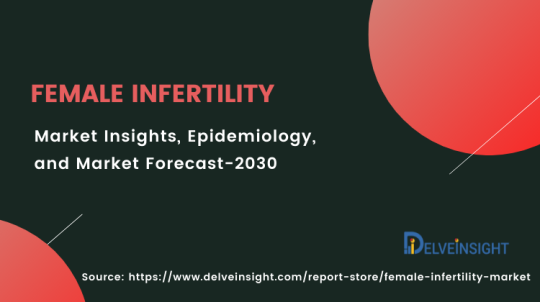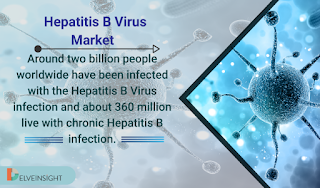Female Infertility Market Scenario, Emerging Therapies and Key Pharma Players Involved
DelveInsight launched a new report on “Female Infertility - Market Insights, Epidemiology, and Market Forecast-2030”.

Female Infertility Overview
Female infertility is defined as trying to get pregnant (having sex regularly) for at least a year without success. About 10 to 18 percent of couples have a difficult pregnancy or childbirth. Infertility is caused by the female characteristics about one-third of the time and male characteristics by about one-third of the time. The cause is unknown or a combination of male and female characteristics in the remaining cases.
The main symptom of infertility is infertility. The menstrual cycle is very long (35 days or more), very short (less than 21 days), and being rare or absent can mean you are not mature. There may be no other signs or external signs.
Female Infertility Causes
The causes of female infertility can be difficult to diagnose. There are many treatments available, depending on the cause of the infertility. Other causes of childlessness may include:
1. Problems with the uterus: These include polyps, fibroids, septum or adhesions within the uterus. Polyps and fibroids can develop on their own at any time, and other abnormalities (such as septum) are present at birth. Adherence can build up after surgery such as cleansing and treatment (D&C).
2. Problems with the fallopian tubes: The most common cause of infertility of the "tubal factor" is genital herpes, which is usually caused by chlamydia and gonorrhea.
3. Problems with ovulation: There are many reasons why a woman does not open (release an egg) regularly. Hormonal imbalances, past eating disorders, substance abuse, thyroid conditions, major depression and pituitary tissue are all examples of factors that can affect ovulation.
4. Problems with egg number and quality: Women are born with all the eggs they have ever had, and this provision can "expire" prematurely. In addition, some eggs will have the wrong number of chromosomes and will not be able to fertilize or grow into a healthy embryo. Some of these chromosomal disorders (such as "balanced distribution") can affect all eggs. Some are random but more common as a woman grows older.
Female Infertility Signs and Symptoms
Symptoms of Female Infertility are listed as:
1. Unusual times
2. Painful or heavy times
3. No times
4. Symptoms of hormonal fluctuations
5. Pain during sexual intercourse
Female Infertility Treatment Algorithm
Infertility treatment depends on the cause, your age, how long you are infertile and your liking. Because infertility is a complex problem, treatment involves greater financial, physical, mental, and temporal commitment.
Although some women need one or two treatments to restore fertility, a variety of treatments may be needed.
Treatment may try to reverse the birth with medication or surgery, or it may help you to conceive more complex techniques.
If women have ovulation problems, they may be given medications such as clomiphene citrate (Clomid, Serophene), gonadotropins (such as Gonal-F, Follistim, Humegon and Pregnyl), or letrozole. Gonadotropins can cause ovulation on Comidid or Serophene is inactive. These medicines can also help you get pregnant by making the ovaries produce more eggs. Usually, only one egg is released each month. Doctors may recommend that you take gonadotropin if the person has a miscarriage or if other treatment does not help in pregnancy. Metformin (Glucophage) is another type of medication that can help with overdose if a person has insulin resistance or PCOS (polycystic ovarian syndrome).
Laparoscopic or hysteroscopic surgery can remove or correct abnormalities to help improve the chances of pregnancy. Surgery can include correcting abnormal uterine conditions, removing endometrial polyps and other types of fibroids that badly form the uterine cavity, or removing pelvic or uterine adhesions.
In cases where the fallopian tubes are blocked or filled with fluid (hydrosalpinx), the doctor may recommend laparoscopic surgery to remove the attachment, enlarge the tube or create a new opening in the bowel. This surgery is rare, as pregnancy rates are usually better with IVF. With hydrosalpinx, removal of the tubes (salpingectomy) or obstruction of the fallopian tubes can increase the chances of IVF pregnancy.
Female Infertility Epidemiology Insights
Female fertility decline has already begun at about 25 to 30 years of age and the median age at last birth is 40-41 years for most educated people who experience natural birth defects.
According to the National Survey of Family Growth (NSFG) data, 15.5% of all women intending to become pregnant are infertile (unable to conceive after one year of experimentation) and 6.7% of married women aged 15 to 44 are infertile.
The prevalence of infertility in older women giving birth is estimated to be 1 in 7 in the western world and 1 in 4 in the developing world. In some regions of the world, including South Asia, other countries in sub-Saharan Africa, the Middle East and North Africa, Central and Eastern Europe and Central Asia fertility rates are about 30%.
In the United States, polycystic ovarian syndrome (PCOS) is one of the most common endocrine disorders in women of childbearing age, at 4-12%. Up to 10% of women are diagnosed with PCOS during a woman's visit. In other European studies, PCOS reporting was reported to be 6.5-8%.
Female Infertility Key Pharma Players:
● Instituto Valenciano de Infertilidad, IVI Alicante/ Merck, S.L., Spain
● Ferring Pharmaceuticals
Female Infertility Pipeline Drugs:
● Pre-treatment with rLH (Luveris 75 IU)
● Menopur® Pen
DelveInsight projected that there are many prospective drugs in pipeline that can enter the Female Infertility market.

Comments
Post a Comment